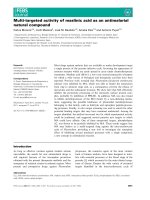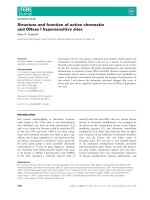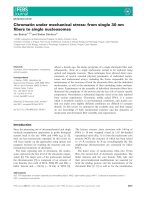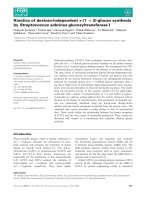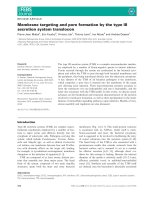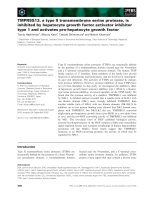Báo cáo khoa học: " GENERATION SIMONIN" pdf
Bạn đang xem bản rút gọn của tài liệu. Xem và tải ngay bản đầy đủ của tài liệu tại đây (385.01 KB, 6 trang )
USING A T~XT MODEL FOR ANALYSIS AND GENERATION
E. FIMBEL, H. GROSCOT, J.M. LANCEL, N. SIMONIN
CAP SOGET I INNOVAT ION
129, rue de l'Universit~
75007 PARIS
FRANCE
ABSTRACT
The following paper concerns a general scheme
for multilingual text generation, as opposed to
just translation. Our system processes the text
as a whole, from which it extracts a
representation of the meaning of the text. From
this representation, a new text is generated,
using a text modei and action ruies.
This process is done in six steps : word
analysis, sentence analysis using a Functional
Grammar, reference soiving and inference,
construction of the text pattern, sentence
generation, and word generation. Different
kinds of information are used st each step of
the process : text organization, syntax,
semantic, etc.
All the knowledge, as well as the text, is
given in a declarative manner. It is expressed
in a single formalism named Functional
Oescriptions. It consists of lexical data, a
Functional Grammar, a knowledge network, action
rules for reference solving and sentence
generation, models of text, rules of
structuration, and sentence schema.
Text representation, included in the semantic
network, is composed of different kinds of
objects (not necessarily distinct) : text
organization, syntactical information, objects
introduced by the discourse, affirmations on
these objects, and links between these
affirmations.
I
TEXT VERSUS
SENTENCES
the one hand rearrange a whole sentence in order
to respect certain stylistic rules and on the
other hand modify the order of these sentences.
Some of them may be deleted and others added.
In any ease, in order to be able to generate
a coherent text by means of the information
extracted from a source text, it seems most
important to us to understand what the text is
refering to.
We have restricted our scope to economic
geography texts, taken from a French review
named ATLASECO. These texts deaI with industry
and agriculture, invoiving reiated concepts
(growth, deciine, production, economicaI
balance ). Our system parses a french text,
integrates its informative content into a
knowledge base, then generates a new text from
information extracted from this base.
We present in part (2) the text
representation used throughout the process. We
describe in part
(3) the
knowledge
representation, based on the functional
descriptions.
In part (4), we briefly describe
the different steps of the process.
2 TEXT REPRESENTATION
A text conveys information by various means.
For example, the order of sentences, as well as
their syntactic structure, may be significant.
The general text representation we use is the
same for understanding and structuring. This
representation includes the different kinds of
information needed for these two processes.
Human translation is a complex process whose
activities are not yet entirely understood.
Generation of text differs from generation of
single sentences : our work stresses the
necessary processing of the text as a whole and
restructuring of this text. A translator must on
The text is represented by a set of
interrelated objects (sentences, words, semantic
objects ). There are five classes of objects,
not necessarily distinct : the visible objects,
the syntactic components, the discursive objects
(defined later), the affirmations and the links.
226
2.1
Visible
Objects
Visible objects are chapters, paragraphs,
sentences, words and word sequences . They are
reiated by positionai iinks, describing the
organization of the text, as shown by the
foIiowing figure :
TEXT
SENTENCE 1
. .
" r='~"J 5ENTEN~En
/ S
/
OB3 1 083 2 083 n OB3 1 083 n
fig. i
These links reflect the hierarchical
organization of the text (chapters ) and the
dependent relationship of statements (order of
sentences ).
2.2
Syntactic
Components
The sentences are represented by means of
unordered "syntactic cases" (subject,
determiner ), linking a component with its
subcomponents. For example :
"the big mouse" ~.~ ~~
body determiner quail fier
J I i
mouse definite big
fig.
Z
2.3 Discursive Objects
Discursive objects represent the semantic
objects
or
entities introduced by the text. For
example :
"The main crop is wheat, whose
production has
strongly
decreased. This decline
has strongly
affected the commercial balance."
These two constructions correspond to a
single discursive object, which could be
calied: "decrease of the production of wheat"
The meaning of a sentence is represented by a
network of discursive objects. The propositions,
represenLing the discursive objects, are
normalized into an objscLive
form.
For example
:
'Peter met 3ohn" -> "meeting of 3ohn by Peter"
"Mary is ill" -> "illness of Mary".
This normalization is very usefui for co-
reference soiving.
The text itself may be a discursive object.
Hence, it is represented by an object which
mentions topic, date and positional links
between sentences of text. Ouring the
Understanding Process, this object will be
enlarged by new information, or modified (for
instance topic may become more explicit).
2.4
Affirmations
Implicit within the text, as well as simply
introducing objects, is the evaluation of
certain objects. "The production is increasing"
introduces "the production" and affirms "the
increase of production".
There are various statement values ("stated
positively in discourse", "dubious" ). These
values may be given by the author, a figure, an
economical organization, etc.
2.5 Links
The links are mainly operators (and, or,
because ) that correlate the affirmations,
which are die cursive objects or links : "A
because B" ; "A and B, but C".
They reflect
internal structure
of discourse.
For example : "the production increases but the
deficit remains important".
During Understanding phase, Lheir main role
is to transmit statement values to the objects
they link.
The structuring stage isolates argumentative
effects of the discourse, and builds new links
(possibly the same). The choice of these links
is important because they have to be coherently
acceptable from the reader point of view.
3 KNOM_EDGE REPRESENTATION
We use the same
representation for
all types
of knowledge in the system : lexical
definitions, grammar rules, semantic rules,etc.
They are given separately in the formalism of
functional descriptions and integrated into the
knowledge base that is represented by a
functional descriptions network.
227
The language of functional descriptions comes
from the functional grammars (DIK 78), which is
a linguistic formalism that can be reiated to
case grammars (FILLMORE 68). Historically, Kay
(81)
used functional descriptions as a genecel
tool to represent grammars, independently of any
specific linguistic theory, after which
Rousselot (84) then
used
functional
descriptions
to represent any kind of knowledge (grammar,
semantic rules, scripts ) in a system of story
understanding.
We will use "DF" instead of "functional
description".
A DF may represent any kind of knowledge. For
example , "William cut himsel~' may be described
by the following figure :
[action = cut
tense = past
actor = [name = Wiiliam]
obj_act <I actor>]
fig. )
A OF is an unorde~ed set of identifier-object
pairs. The identifiers are not pre-defined :
they may be added or removed in any way. This
allows us to put various kinds of information in
the same description : syntactic, semantic, etc.
The objects may be other DFB or
paths.
A path is a notation whose aim is to point
to objects that ace already defined . We have
two kinds of paths :
- A local path <I list-of-identifier> points to
an object in the current OF, as defined by the
list of identifiers. For example, in fig. 3,
the path <I actor name> cefers to "William".
- A global path, <g starting-point list-of-
identifiers> points to an object in the
knowledge base. It is defined in the same way
as the local path, except that the starting
point is the curcent DF.
The internal representation of a DF is a
labelled graph. For example, the representation
of the DF in fig. ) is shown in fig. 4.
as input and converts it directly into the
labelled graph as shown in fig. 4, which is then
integrated into the knowiedge base.
A functional description network is the graph
that represents a set of interlaced DFB, i.e.
the knowledge base. This network is a labelled
graph whose nodes correspond to OFs, and whose
links to elementary object properties. These
links are labelled with identifiers.
colour
table = ~ blue
object (DF) property object (OF)
fig. 5
Each identifier (e.g. colour) may be given
different propecties (e.g. inhecitance
properties). This is done through attaching a
node to the identifier.
The graph may contain Dynamic Paths , which
allow access to the objects. A dynamic path is a
function <f starting-point list-of-identifiers>
whose value is a node on the graph. Foc example,
in fig. 4, the dynamic path <f (M) actor name>
points to the node "William". Dynamic Paths ace
very similar to substituable variables in formal
systems.
The processing of a DF network can be done at
two levels :
- elementary
level : insert or delete links
(i.e. propecties) or nodes (i.e. objects) ;
-
form level : each node of the netwock can
still be viewed as a description, which
corresponds to a complex set of links. This
allows us to work on the form of the
objects (pattern matching and merging).
The main algorithms that operate at the form
level are those of compatibility (pattern
matching) and merging. "Compatilibity" is a
boolean function that decides whether two
descriptions may correspond to the same object
of the real world. For example, could the events
described by "William speaks to himselP' also be
described by "Somebody speaks to Ted" 7 :
7 cut William
tense~ past
Fig. 4
The system takes the DF, as shown in fig. 3,
~action
=
speak
actor ~name = William]
obj-act = <I actor>J
[action = speak
actor
= ~
is-a
=
huma~
obJ-act = [ name Ted]J
fig. 6
228
These two descriptions are
not
compatible,
because the name of ,he "obj-act" is "William"
on one hand and "Ted" on the other.
"William cut himself "
action
=
cut
tense = past
actor = [name =
obj-act <1 actor>]
William]
"X cut Y"
[action = cut
tense = past
actor.
=
[is-a
=
human] .
obj-act Estate
changed]J
[action
=
cut
tense
=
past
actor
=[
is-a
=
human
name = William
state = changed]
obj-act
=
<I actor>]
fig.
7
Two compatible descriptions can be merged.
The result is a new description, more complete
than either of the originals. For example, the
first two DFs of fig. 7 are compatible, and give
the third one as the result of merging.
These two algorithms, inspired by the
functional unification introduced by Kay, are
very powerfuI and are used at each step of text
processing. Their precise definitions use
mathematicaI transformations of iabeIIed graphs
and are given in (GROSCOT, ROUSSELOT 85).
/4 TEXT PROCESSING
In this section, we describe the following
different steps of the text processing :
- word anaiysis
- sentence anaIysis
- reference solving
- construction of the text pattern
-
sentence generation
- word generation
/4.1 Word Analysis
The word analyser uses a knowledge base about
the standard inflexions of the initial language
and a dictionary of words and sequences of
words. Each item in the dictionary contains a
semantic definition, its syntactical category,
and its type of infiexion with its roots.
We generate for each word a description of
its syntactic features. AII soiutions are
generated. For exampie, the analysis of the word
"burns" gives at least these two DFs :
i)
[word
= burn
number = plural
category = substantive
"'" ]
2) [word
= burn
category = verb
tense = present
person = 5
number = singular
o,, ]
fig.
8
/4.2 Sentence Analysis -
The analyser is based on the work of
Rousselot (8/4). It works sentence by sentence
and assumes three important functions :
-recognition and construction of syntactic
components of a sentence
-controI of semantic constraints
-
generation of the semantic representation of
the sentence, i.e. an affirmation or a link
The analyser uses a declarative grammar,
which does not depend upon the way in which the
anaiyser works. The grammar is a DF, in which
each identifier-object pair represents a grammar
ruIe. These rules aliow the analyser to spiita
syntactical category into constituents, to
verify the constraints, and to build the
associated semantic representation.
The analyser works in a top-down manner by
means of an agenda which allows the separation
of the controls. Also included in the anaIyser
is a graph that contains the partiaI anaiysis
which minimizes processing time during the
backtracks.
The starting point of this analyser is the
set of DFs which have been obtained and graphed
after word analysis.
We show here, in an example, the result of
the analysis of the sentence "Agriculture is a
success" :
object : success
evaluated-object : [object = agriculture
def-undef = definite]
statement-value = true ]
fig. 9
229 "
4.3 Reference
Solving
This stage determines what the pronouns and
noun phrases point to: known objects (already
in the knowiedge base), or new objects
introduced (directly or indirectly) by the text.
The process uses action rules, written by
means of OFs. The rules interpreter works in a
"lazy" saturation mode : It locally saturates
the knowledge base regardless of whether or not
all inferences have been made.
The process has three main features :
-it is directed by the syntax (definite
articles, pronouns )
-it identifies the objects at the semantic
level, by testing the compatibility of
discursive objects
-it uses positional links to define the
possible references in each case. For example,
a demonstrative pronoun has to be found among
the preceding objects of the text
It
has
two important effects :
- it constructs a coherent network of discursive
objects (the "meaning" of the text)
-
it integrates the text into the knowledge
base : each time that the text refers to a
known object, links are created from this
object to the text
When this is done, the position of the
information, may be inadequate for a coherent
text. Therefore, the text structure is changed :
some information is enhanced ; the paragraphs
are balanced ; the information is reordered
according to chronological order and
significance at the deepest level of the text
structure.
At this step, output text structure is
clearly apparent. But it is not sufficient
because the text has now become a sequence of
unrelated statements. Links are then created
between the discursive objects introduced in the
text (conjunctions, pronouns ) and ellipses
are used to avoid repetitions.
4.5 Sentence
Generation
From each OF of the text describing output
information, this stage generates the
description of a suitable sentence.
Syntactic patterns are associated with
concepts (evolutions, appreciations,
numbers ). Action ruIes combine these patterns
to create the description of a sentence, i.e. a
iist of word descriptions.
4.4 Construction of
the text pattern
Once the initial text has been analysed, its
informative content is integrated in the
knowledge base, thereby making it possible to
question this base and to reformulate the so-
obtained information with the aim of generating
a
new text.
This stage builds the text structure
(paragraphs, sub-paragraphs, sentences ) using
two complementary approaches : the content of
information and the evoIution of the
visible
structure
of the text. Indeed, text generation
is a refIective process : generation of a singIe
sentence of the text must take account the
preceding and following text. All the processes
used for structuring are written by means of
rules.
The starting point of structuring is a set of
information extracted from the knowledge
network.
First, all the information is inserted into a
text model by means of their topics. Some
obvious redundancies are eliminated : only one
occurrence will be kept, in the most appropriate
place.
A.6 Word Generation
Word generation uses the same organization of
the knowledge base (about standard inflexions)
as word anaiysis.
From a list of word descriptions, inciuding
syntactic features, the system constructs the
output word. For example :
word
=
burn
cat = verb
tense = present
person = ) > B U R N S
number
=
singula d
fig. i0
.5 ANALYSING ECONOMIC GEOGRAPHY TEXTS
The texts we have analysed, taken from the
French review ATLASECO, describe the main
features of the agriculture in different
countries. They contain an average of 20
sentences, which contain from i0 to 45 words.
230
The system used :
- 400 lexical items, which represent 2400 words
-
70 grammar ruies
- a semantic network containing 220 concepts, 80
of them being domain-dependant
-
80 semantic ruIes for inference and reference
solving
-
i text model, containing 50 paragraphs and
subparagraphs
- lO0 rules for text structuring
-
30 sentence patterns for generation
Our system was able to extract the
significant information that such a text
conveys, and produce a new text from this
information. As a matter of convenience, we used
French as the target language for validation,
however the process described here should also
be able to work in a manner independant of the
target language, by chaining certain parts of
the knowledge base.
Now, we are in the process of adapting our
system to generate French appliance operation
manuals from the corresponding ones.
REFERENCES
ATLASECO
Atlas dconomique mondial
Le Nouvel Observateur, 1982.
DIK Simon
"Functional Grammar"
Publications in Language Science.
Foris Publications, Oordrecht Holland, 1978.
FILLMORE
Charles
"The case for case" in "Universals in
Linguistics Theory", E. Bach and R. Harms
(ede), p.i-90, 1968.
FIMBEL Eric
"Les reseaux miroirs : un mdcanisme d'infd-
fence gdndraI ;appiication hun syst~me
d'aesimiiation de textes"
Th~se de l'universitd Paris 6, mars 1985.
GRIZE Jean-Blaise
"Introduction h la logique naturelle et
approche logique du dialogue"
Approches formelles de la sdmantique naturelle.
Publication
CNRS-UPS-UTM-ADI, 1982.
GROSCOT Herbert, ROUSSELOT Franqois
"Un langage ddclaratif uniforme et un
analyseur syntaxico-sdmantique"
Proceedings of Cognitiva, Paris, juin i985.
GROSS Maurice
"Mdthodes en syntaxe"
Hermann, 1975.
KAY Martin
"Unification Grammars"
Xerox internal publication, 1981.
McKEOWN Kathleen R.
"Generating natural language text in response
to questions about database structure"
PH.D of the university of PennsyIvania, 1982.
ROUSSELOT Francois
"Rdalisation d'un programme comprenant des
textes en utiIisant un formaiisme ddclaratif
pour reprdsenter toutes les connaissancee"
Th~se d' dtat, Paris 6,
1984.
SIMONIN Nathalie
"Utilisation d'une expertise pour engendrer
des textes structurds en fcan~ais"
Th~se de l'universit~ Paris 6, mars i985.
231
